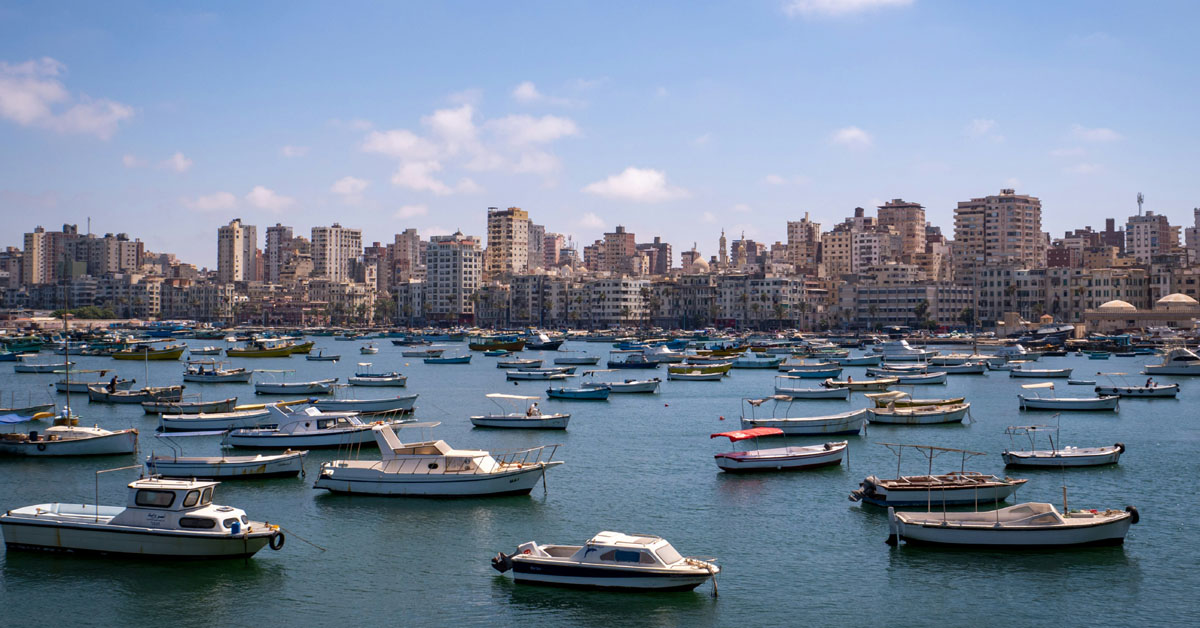18 Best Things To Do In Alexandria, Egypt
8 min read
From Greco-Roman ruins and seaside fortresses to savory seafood and historic cafes, here are the best things to do in Alexandria.
1. Bibliotheca Alexandrina
This ultra–modern library with its sun disc facade is a re-imagining of Alexandria’s famous ancient library.
Built near the site of the ancient library, the Bibliotheca Alexandrina is a cylindrical mammoth on the corniche that holds up to 1.8 million volumes.
It has a massive reading room and a host of fascinating exhibits to stroll through downstairs, including the Manuscript Museum with its collection of ancient scrolls and texts.
There’s also an Antiquities Museum that holds a collection of Graeco-Roman statues found underwater at Alexandria’s harbor. And don’t miss the Science Museum and Planetarium for children.
The Bibliotheca Alexandrina is a bucket-list destination for any bookwork – from its quirky book-shaped benches to its rotating art exhibits and curiosities.
2. Fort Qaitbey
This sparkling fortress on the Mediterranean was built in the 1480s by Sultan Qaitbey to protect the city from Crusaders.
Fort Qaitbey boasts beautiful architectural details and sweeping views of the deep blue sea just beyond dotted with fishing boats.
It was built on the site of the famous Pharos Lighthouse, one of the lost wonders of the ancient world that was destroyed by a tragic earthquake in 1303. Some stones recovered from the lighthouse wreckage were used to build this medieval wonder.
Climb up to the roof for some of the best views in the city, especially dazzling a sunset (the fort closes at 7pm).
3. Stroll the Corniche
No visit to Alexandria is complete without a stroll down this 3-kilometer walkway lined with lively cafes, upscale restaurants and historic hotels.
Cross the busy roadway to grab a seat on the concrete blocks along the water for sweeping views of the sea – even the fort of Qaitey is visible at some points.
Watch the fishermen reeling in their catch or strike up a conversation with a local – Alexandrians are always curious to meet visitors.
Grab some street food from the circling vendors (like chickpeas) or enjoy lunch at one of the historic cafes across the street. You’ll spot historic landmarks like the Windsor Palace Hotel and other grand buildings that testify to Alexandria’s cosmopolitan past.
My favorite stretch of the corniche is alongside the Steigenberger Cecil Hotel, a vintage gem that hosted legends like Agatha Christie and Winston Churchill.
4. Catacombs of Kom el Shoqafa
These 2nd-century underground tombs are a dazzling fusion of Ancient Egyptian and Greco-Roman styles.
Full of burial chambers and a chapel down a spiral staircase, these ancient catacombs weren’t discovered until 1900 when a donkey accidently fell straight into them.
The catacombs were used to bury the dead – three sarcophagi have been found to date along with human and animal remains. There’s even a hall that contains tombs for the horses of Roman Emperor Caracalla.
There’s also a banquet hall where those visiting the tombs would eat and drink. They would break all their dishes after the meal because they didn’t want to bring containers home from a place of death.
5. Montaza Palace and Gardens
This splendid 19th-century palace – overlooking the Mediterranean in Alexandria – was once the summer residence of Egyptian royalty.
Today, Montaza Palace is famous for its gardens with their avenues of palms, miniature palaces, pavilions and manicured flower beds.
The Salamlek Palace was first built in 1892 as a hunting lodge for the royal family. The larger Haramlek Palace and gardens were later added in a beautiful mix of Ottoman and Florentine styles.
The 350-acre gardens are well worth a visit for their sea views and restaurants in the park. And there’s also a beautiful hotel right on the grounds. The Helnan Royal overlooks the sea. And it was built in 1964 to house dignitaries visiting Egypt for the second-ever Arab League Summit.
6. Kom el Dikka
This small 4th-century Roman amphitheater includes remnants of a university complex, beautiful mosaics and Roman baths.
And it wasn’t even discovered until 1960 when the area known as the “mount of rubble” (kom el dikka) was being cleared to build new housing.
The amphitheater is remarkably well intact and once held 800 people for events like plays and wrestling matches. The complex also holds 22 lecture halls that testify to Alexandria’s role as a center of learning in the ancient world.
Don’t miss the beautiful Villa of the Birds, an upscale urban villa decorated with mosaics that depict 9 vibrantly colorful birds.
7. Royal Jewelry Museum
The Royal Jewelry Museum boats an impressive collection of more than 11,000 pieces of royal jewelry, coins, clocks and portraits of Egypt’s royal family.
It’s housed inside the Fatma Al-Zahra Palace, an architectural gem known for its blend of European and Islamic styles.
The palace was completed in 1923 and served as a residence for the princess. It’s filled with paintings, gilded ceilings and ostantatious pieces like gold chessboards and jewelry commissioned by European designers.
The princess’s property was confiscated after the 1952 Egyptian Revolution. And it was turned into a public museum in 1986.
8. Alexandria National Museum
This brilliant museum chronicles Alexandria’s history with some 1,800 pieces from the Pharaonic and Graeco-Roman periods through recent excavations.
Head to the basement for Pharaonic era artifacts. And then see the Hellenistic gems of Alexandria’s prime when it was ruled by the Ptolemy dynasty and Alexander the Great.
The first floor has (relatively) more recent pieces from the Coptic and Islamic periods.
And don’t miss the fascinating exhibit of artifacts from the underwater excavations of the sunken city of Heracleion-Thonis, which includes a statue of Alexander the Great.
9. Pompey’s Pillar
This imposing 25-meter red granite pillar was raised as a tribute to Emperor Diocletian – and it’s truly awe-inspiring in real life.
The pillar sits atop the ruins of the Temple of Serapis (or the Serapeion), which once honored the Greco–Egyptian deity of the sun. The temple was also used to store surplus manuscripts from the ancient Library of Alexandria – and you can still see those underground chambers today.
The pillar has nothing to do with Pompey and it actually honors Diocletian, who fed a starving population during a siege of Alexandria.
10. Abu Al Abbas Al Mursi Mosque
Abu Al Abbas Al Mursi is the oldest and most historic mosque in Alexandria built over the tomb of a 13th-century Sufi saint.
Abu Al Abbas Al Mursi was an Andalusian sheikh who spent much of his life in Alexandria. His tomb later became a popular pilgrimage spot for Muslims heading to Mecca.
A mosque was built over the shrine in 1307 and the complex was expanded over the centuries. It was finally completed in the 1940s with renovations by a pair of Italian architects.
The interior contains gorgeous painted ceilings, columns and intricate carvings with Quranic verses. The shrine to the Sufi mystic still attracts devotees.
This mosque stands in a large square just off the corniche, not far from the Qaitbay Citadel. It’s an easy sightseeing stop on your way to the citadel.
11. Stanley Bridge
Take a stroll across this Alexandrian landmark for some fresh air and gorgeous views.
Stanley Bridge is 400 meters long with pairs of Italian Florentine towers at each end. It was built to ease Alexandria’s traffic congestion – and it’s now a popular local destination for evening walks and photo ops.
And because it’s Egypt, you’ll find lots of street food, snacks and cafes in the area.
12. Dive underwater at Cleopatra’s Palace
Cleopatra’s Palace is an incredible diving site where you can explore the ruins of an ancient underwater city.
Book a scuba diving tour to explore the toppled columns and statues submerged underwater in what’s thought to be Cleopatra’s former residence.
This once glorious palace met a tragic end when an enormous earthquake struck the city.
It’s now filled with toppled columns, sunken sphinxes and underwater statues. It’s a surreal experience to explore these ancient underwater relics suspended just under the surface.
13. Dig into Alexandria’s seafood
Alexandria is famous for its fresh seafood – and for rich and spicy dishes that are part of the local cuisine.
But this coastal city is best known for its juicy seafood – made piping hot with the daily catch from the morning fish market.
Dine at one of the city’s upscale waterfront restaurants on the harbor for heaping plates of shrimp and barbouni (red mullet) with a view.
Or head to the working-class district of Anfushi for lively coffee houses and street food like grilled fish wrapped in the local baladi flatbread.
I recommend the White and Blue Restaurant at the Greek Nautical Club (just a short walk from Fort Qaitbey) for its sweeping Mediterranean views and juicy sea bass.
14. Mamoura Beach
Mamoura Beach is a great central private beach where you can lounge in the soft sand with a cold drink.
The beach is equipped with chairs and umbrellas, showers, restrooms and chancing cubicles that make it an easy choice in the center of town.
Mamoura is one of the cleanest and nicest beaches in Alexandria – and the sand is much softer than other rockier beaches. It’s a great spot to take a breather from sightseeing and get a drink from a nearby cafe.
15. Ras el-Tin Palace
The lavish 19th-century Ras el-Tin Palace on the Alexandrian harbor was once the royal summer residence of the Muhammad Ali dynasty.
It’s also where Egypt’s last monarch King Farouk sought refuge during the 1952 Egyptian Revolution as he was besieged by army forces. He famously sailed off from the palace into exile in Italy.
Today this Italian Renaissance gem is still in use (by the Navy) and it’s closed off to the public. But you can view the palace gardens and the glorious facade from the water.
16. El Horeya Road (aka Fouad St.)
Fouad is one of the city’s most historic streets lined with belle epoque buildings and shops that recall Alexandria’s cosmopolitan past.
Take a stroll past the antique shops and old restaurants to see the footprints left by the city’s immigrant communities (including Greek, Armenian and Italian).
And stop by SHELTER Art Space, just off El Horeya Road, for one of my favorite Alexandria hidden gems – a gallery full of cutting-edge Egyptian artists housed inside a former World War II bomb shelter.
Fouad Street is one of the oldest established roads in the world. Authors like Laurence Durell, who penned The Alexandria Quartet, and poet Constantine Cavary were both inspired by this historic street in their works.
The street is locally known as Fouad Street, though you’ll find it on Google Maps under its official name – El Horeya Road.
17. Mahmoud Said Museum
Housed inside a beautiful Italianate villa, the Mahmoud Said museum is a fascinating look at a criminally underrated Egyptian artist.
Mahmoud Said (1897–1964) is considered the founder of modern Egyptian art – and a rare Arab artist whose work fetches millions at international auctions.
The museum gives an impressive overview of his work from colorful landscapes and portraits to nudes. It’s about a 15-minute walk from the Royal Jewelry Museum.
18. Cavafy Museum
This small museum chronicles the life and works of Constantine Cavafy (1863-1933), a Greek-Alexandrian poet who captured the city’s Hellenistic roots.
The museum was once the poet’s residence and contains some of the original furniture along with photos, letters and manuscripts.
And it’s wildly popular with Greek tourists, who consider Cavafy one of their greatest modern poets.
Cavafy’s poetry was championed by English novelist E.M. Forster, though he didn’t gain recognition until after his death.


